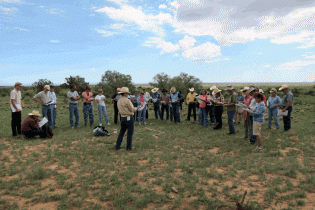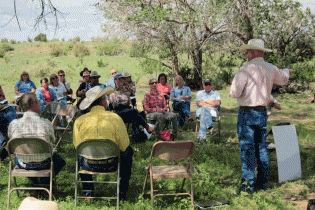As if on cue, the rain clouds built as 36 participants showed up at HMI’s Open Gate Ranch Day at Mesteño Draw Ranch in Mountainair, New Mexico to learn about effective grazing management practices and how to monitor land health to make effective grazing management decisions during a drought—even when the rains begin.
HMI Director of Community Services and Certified Educator, Ann Adams facilitated this ranch day, hosted by Joan Bybee of Mesteño Draw Ranch, which involved many opportunities for small group exercises and peer-to-peer learning focusing on riparian and upland monitoring as well as discussions on the challenges of how and when to graze plants that were stressed by the drought. Many participants expressed their appreciation for Joan’s willingness to share her experience and challenges as well as the information shared by ranchers Melvin Johnson of Ranney Ranch in Corona, New Mexico and Brian Greene, another Mountainair rancher. Kenneth Lujan, NRCS District Conservationist for Mountainair and the Claunch-Pinto Soil and Water Conservation District also provided critical information about plant health and grazing practices.
There was a great diversity of participants with approximately 25% of participants who did not ranch but wanted to learn more about sustainable ranching practices. Some of these participants were small-land holders who owned horses. Approximately 50% of the participants were beginning ranchers who had been ranching for less than 10 years.
There was a lot of great learning from the small group work with plant identification as a particular favorite. A prolific small yellow forb had everyone stumped. A participant was able to later identify it as Abert’s Zinnia. Participants were excited to learn the practical skills of forage assessment and biological monitoring that they could then take back to their operations and land. Likewise, the large group discussion had everyone engaged in how to apply what they had learned about the landscape regarding the issues of animal performance, destocking strategies, financial ramifications, and value-added marketing to address profitability in reduced production areas due to drought.
Thanks to our host for the day, Joan Bybee. Thanks also to our funders and sponsors, the CHS Foundation, Adelante Consulting Services, Claunch-Pinto SWCD, Rocky Mountain Farmers Union, New Mexico Land Link, La Montanita Cooperative, the Southwest Grassfed Livestock Alliance, and the Manzano Mountain Arts Council.
Evaluations of the program show that 100% of the participants were satisfied with the program. 88% of participants experienced some knowledge change with an average of 44% change in knowledge. Participants manage over 196,644 acres which will now be managed differently as a result of this program.
Participant Response to the Program:



